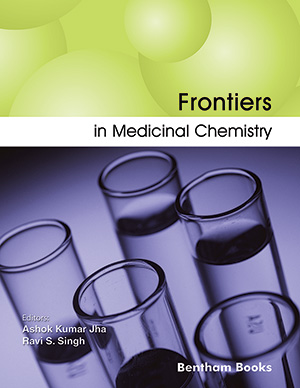Abstract
High uric acid (UA) levels have been correlated with a reduced risk of many neurodegenerative diseases through mechanisms involving chelating Fenton reaction transitional metals, antioxidant quenching of superoxide and hydroxyl free radicals, and as an electron donor that increases antioxidant enzyme activity (e.g. SOD). However, the clinical usefulness of UA is limited by its’ low water solubility and propensity to form inflammatory crystals at hyperuricemic levels. This review focuses on the role of UA in neuroprotection, as well as potential strategies aimed at increasing UA levels in the soluble range, and the potential therapeutic use of more water-soluble methyl-UA derivatives from the natural catabolic end-products of dietary caffeine, theophylline, and theobromine.
Keywords: Aging, Antioxidant, Caffeine, Neurodegeneration, Theobromine, Urate Oxidase, Uric acid.
Current Topics in Medicinal Chemistry
Title:The Role of Uric Acid and Methyl Derivatives in the Prevention of Age-Related Neurodegenerative Disorders
Volume: 15 Issue: 21
Author(s): Roy G. Cutler, Simonetta Camandola, Kelli F. Malott, Maria A. Edelhauser and Mark P. Mattson
Affiliation:
Keywords: Aging, Antioxidant, Caffeine, Neurodegeneration, Theobromine, Urate Oxidase, Uric acid.
Abstract: High uric acid (UA) levels have been correlated with a reduced risk of many neurodegenerative diseases through mechanisms involving chelating Fenton reaction transitional metals, antioxidant quenching of superoxide and hydroxyl free radicals, and as an electron donor that increases antioxidant enzyme activity (e.g. SOD). However, the clinical usefulness of UA is limited by its’ low water solubility and propensity to form inflammatory crystals at hyperuricemic levels. This review focuses on the role of UA in neuroprotection, as well as potential strategies aimed at increasing UA levels in the soluble range, and the potential therapeutic use of more water-soluble methyl-UA derivatives from the natural catabolic end-products of dietary caffeine, theophylline, and theobromine.
Export Options
About this article
Cite this article as:
G. Cutler Roy, Camandola Simonetta, F. Malott Kelli, A. Edelhauser Maria and P. Mattson Mark, The Role of Uric Acid and Methyl Derivatives in the Prevention of Age-Related Neurodegenerative Disorders, Current Topics in Medicinal Chemistry 2015; 15 (21) . https://dx.doi.org/10.2174/1568026615666150610143234
| DOI https://dx.doi.org/10.2174/1568026615666150610143234 |
Print ISSN 1568-0266 |
| Publisher Name Bentham Science Publisher |
Online ISSN 1873-4294 |
Call for Papers in Thematic Issues
Chemistry Based on Natural Products for Therapeutic Purposes
The development of new pharmaceuticals for a wide range of medical conditions has long relied on the identification of promising natural products (NPs). There are over sixty percent of cancer, infectious illness, and CNS disease medications that include an NP pharmacophore, according to the Food and Drug Administration. Since NP ...read more
Current Trends in Drug Discovery Based on Artificial Intelligence and Computer-Aided Drug Design
Drug development discovery has faced several challenges over the years. In fact, the evolution of classical approaches to modern methods using computational methods, or Computer-Aided Drug Design (CADD), has shown promising and essential results in any drug discovery campaign. Among these methods, molecular docking is one of the most notable ...read more
Drug Discovery in the Age of Artificial Intelligence
In the age of artificial intelligence (AI), we have witnessed a significant boom in AI techniques for drug discovery. AI techniques are increasingly integrated and accelerating the drug discovery process. These developments have not only attracted the attention of academia and industry but also raised important questions regarding the selection ...read more
From Biodiversity to Chemical Diversity: Focus of Flavonoids
Flavonoids are the largest group of polyphenols, plant secondary metabolites arising from the essential aromatic amino acid phenylalanine (or more rarely from tyrosine) via the phenylpropanoid pathway. The flavan nucleus is the basic 15-carbon skeleton of flavonoids (C6-C3-C6), which consists of two phenyl rings (A and B) and a heterocyclic ...read more
 60
60 3
3 1
1
- Author Guidelines
- Graphical Abstracts
- Fabricating and Stating False Information
- Research Misconduct
- Post Publication Discussions and Corrections
- Publishing Ethics and Rectitude
- Increase Visibility of Your Article
- Archiving Policies
- Peer Review Workflow
- Order Your Article Before Print
- Promote Your Article
- Manuscript Transfer Facility
- Editorial Policies
- Allegations from Whistleblowers
- Announcements
Related Articles
-
Editorial (Thematic Issue: Molecular Modeling, Molecular Dynamics and Bioinformatics in Pharmaceutical Design)
Current Pharmaceutical Design WISP1 (CCN4) Autoregulates its Expression and Nuclear Trafficking of β-Catenin during Oxidant Stress with Limited Effects upon Neuronal Autophagy
Current Neurovascular Research New Targets for Therapy in Polyglutamine (polyQ) Expansion Diseases
Current Drug Therapy Growth Factors and Astrocytes Metabolism: Possible Roles for Platelet Derived Growth Factor
Medicinal Chemistry Network Pharmacology of Ayurveda Formulation <i>Triphala</i> with Special Reference to Anti-Cancer Property
Combinatorial Chemistry & High Throughput Screening Emerging Therapeutic Approaches Based on Nanotechnology for the Treatment of Diseases Associated with Telomere Dysfunction
Mini-Reviews in Medicinal Chemistry Autoimmunity and Frontotemporal Dementia
Current Alzheimer Research Autophagy: For Better or for Worse, in Good Times or in Bad Times …
Current Molecular Medicine Dietary Polyphenols for Treatment of Alzheimer’s Disease– Future Research and Development
Current Pharmaceutical Biotechnology Synthetic Applications of the Nenitzescu Reaction to Biologically Active 5-Hydroxyindoles
Current Organic Chemistry Antibody Fusion Proteins: Applications in Brain Targeting
Current Medicinal Chemistry - Central Nervous System Agents RNA G-Quadruplex: The New Potential Targets for Therapy
Current Topics in Medicinal Chemistry New Perspectives on Machine Learning in Drug Discovery
Current Medicinal Chemistry Receptor Heteromers in Parkinson’s Disease and L-DOPA-Induced Dyskinesia
CNS & Neurological Disorders - Drug Targets Understanding Gender Differences in Schizophrenia: A Review of the Literature
Current Psychiatry Reviews Myopathic Involvement and Mitochondrial Pathology in Kennedy Disease and in Other Motor Neuron Diseases
Current Molecular Medicine Editorial (Hot Topic: Organic Solute Transporters and Diseases: Potential Therapeutic Targets)
Current Molecular Pharmacology Nanotechnology for Alzheimer Disease
Current Alzheimer Research Catalytic DNA: A Novel Tool for Gene Suppression
Current Drug Targets Commentary: Stephen William Hawking (8 January 1942 – 14 March 2018)
CNS & Neurological Disorders - Drug Targets
























